Centennial Parklands features an impressive collection of 15,000 trees across 360 hectares - most of which were planted in the late 19th and early 20th century.
If your passion is trees, Centennial Park, Moore Park and Queens Park all have many fine examples of Australian figs, evergreen oaks, exotic pines, eucalypts and paperbarks. Of these, Centennial Park contains the largest concentration of tree species and specimens. We feature 230 different tree species and 60 + genera amongst an adundance of native plants and shrubs.
Meet Pete
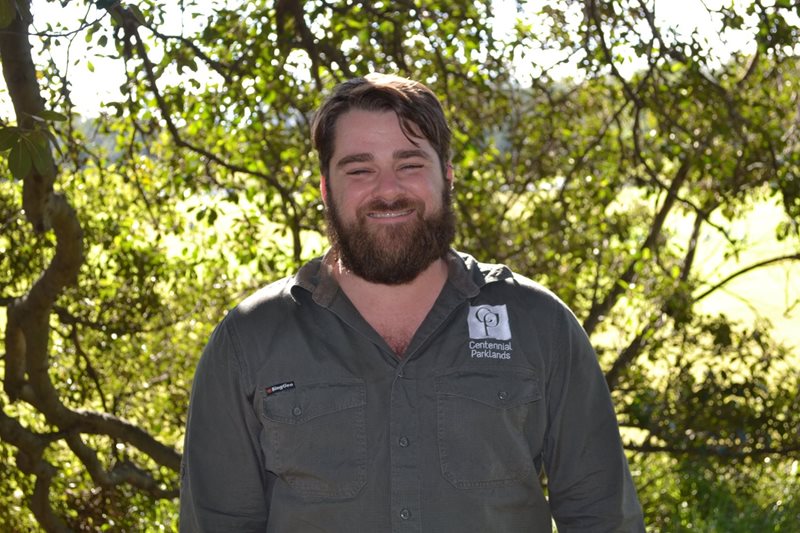
My name is Peter Butler and I am the Senior Arborist for Centennial Parklands. I am lucky enough to have the responsibility of conserving and maintaining our diverse tree collection, alongside my team, Matt and Michael. Our passionate team of arborists systematically assess, maintain and add to our tree collection, consisting of more than 15,000 trees, using our skills and expertise to monitor their health, structural integrity and wellbeing.
I often get asked what my favourite trees are so I thought I would share my top 10 from the Eastern ends of our Parklands and turn it into a trail for you so you can see for yourself why they are so unique and special.
Follow the map below starting in Queen's Park north and journey into Centennial Park east through Musgrave Avenue until you reach Willow Pond. It is around 1.65 km in length and should only take you around an hour to complete, depending on the amount of time you stop to admire each of the tree's beauty and unique attributes.
If you liked the trail share your pictures with us by tagging on social using @centparklands #centennialparklands
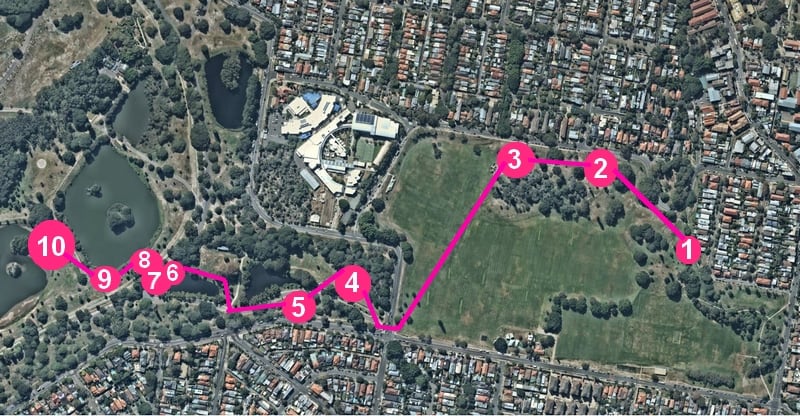 Start in Queens Park north and make your way over to Centennial Park east
Start in Queens Park north and make your way over to Centennial Park east
Stop 1: Ficus rubiginosa, Port Jackson fig
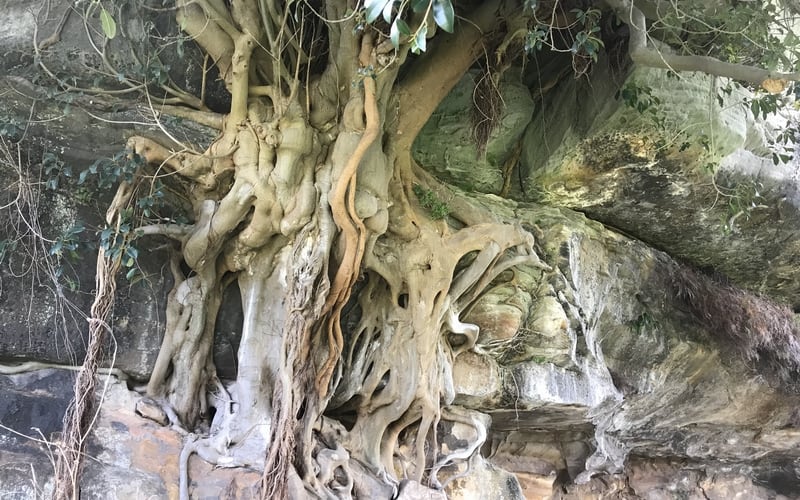 Location: Cliff-face walkway, Queen’s Park
Location: Cliff-face walkway, Queen’s Park
This self-sown Port Jackon fig tree is naturally occurring and not planted, however it is local to the area and is monitored and maintained as part of our tree collection.
Like all figs, they can start and spend much of their life above the ground, high in a tree canopy (epiphyte) or on a rock (lithophyte). This beautiful specimen’s roots cascade down this natural cliff as it clings to the rock crevices and follows the moisture trails down its face.
I love how these aerial roots provide a rare opportunity to view how intricate and complex a trees’ support and plumbing network is, whilst also looking like a wall from the set of James Cameron’s ‘Aliens’.
The roots bulge and contort as they meet new surfaces and although systematic as they work their way down with gravity, they seem to get ‘distracted’, forming a disorderly but dynamic entanglement.
Stop 2: Ficus macrophylla, Moreton Bay fig
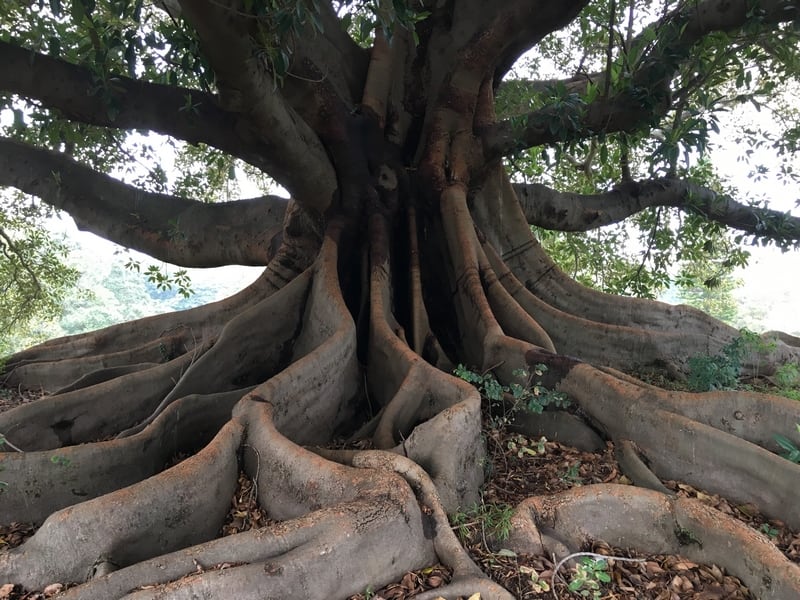 Location: Queen's Park North
Location: Queen's Park North
This is one of three giant Moreton Bay figs in Queens Park estimated to be older that the Park, which was opened in 1888. These three examples are the biggest in the Parklands where they have the room to grow unimpeded and not impacted by various other urban stresses.
The other two trees can be seen not far from this one, bordering the Park towards the east. This one stands out to me due to its regal stature as it stands and sprawls outward on top of the natural sand dune. This trees’ branching and prominent buttress roots reminds me of the Celtic Tree of Life where the branches link gracefully to the structural roots as they flow down and away from the trunk.
A certain symmetry can be recognised between the branches reaching for the sky and the ever-supporting roots reaching outward and beyond. If you walk amongst the swirling buttresses, you may notice their division and even sometimes crossing over each other as they fuse back together. I find it a great exercise in mindfulness to look for intricate patterns, shapes and I have even spotted a couple of inward spiralling scrolls.
Stop 3: Ficus rubiginosa, Port Jackson fig
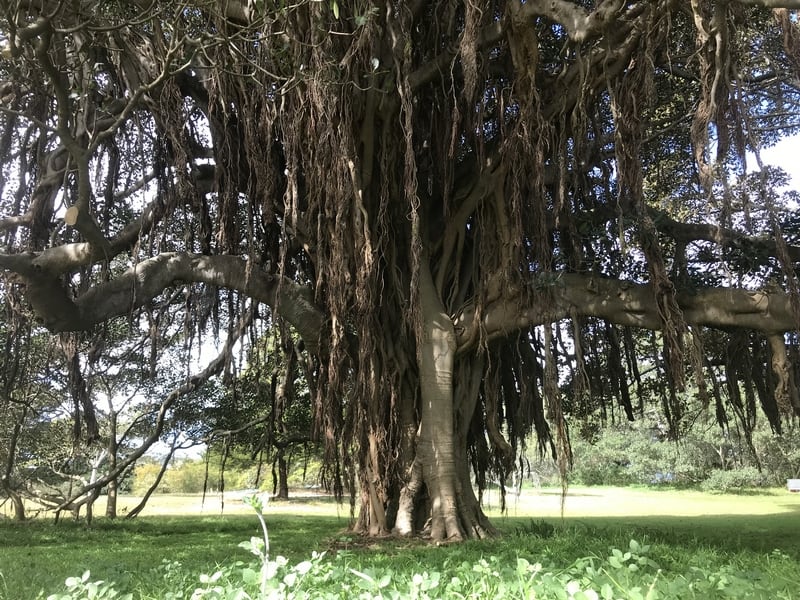 Location: Queen's Park North
Location: Queen's Park North
Although a common feature in this fig species, this tree displays an unusual abundance of aerial roots. Aerial roots are produced by the tree adventitiously and are produced dependant on a variety of factors such as species, microclimate or genetic predisposition.
They assist the tree in absorbing ambient moisture in humid environments and slowly, but surely, extend to reach the ground, becoming woody and supporting the branch to extend its growth beyond the reach of its canopy.
The roots grow straight down with gravity but if you look closely you can see some on an angle, where the weight of the supporting branch has increased due to growth and time, and these ones have already lignified (become woody) as they were formed long ago. They remind me of stalactites, which are formed over decades in limestone caves.
Stop 4: Quercus virginiana, Southern live oak
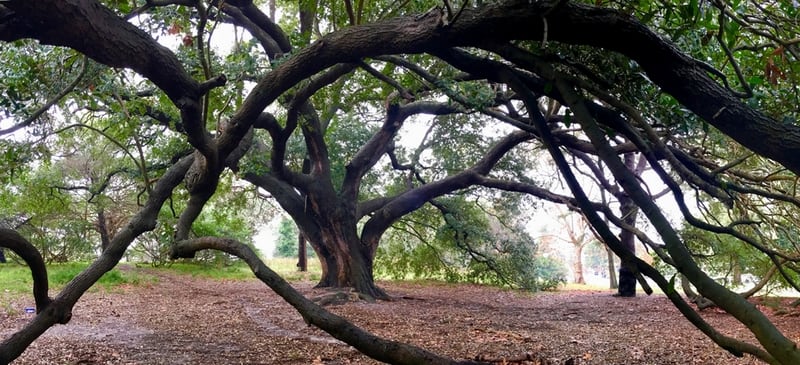 Location: Musgrave Pond East
Location: Musgrave Pond East
This champion tree is one of Centennial Parklands largest evergreen oaks, which grow well in our temperate environment. Centennial Park is iconic for these oaks but unlike most, which flank Grand Drive, this one grows in a quiet corner within the Musgrave precinct.
This particular tree is 99 years old and matches its age with its huge girth and long sprawling branches. It is one of 5 trees from Centennial Park recorded on the National Register of Big Trees but wins by a mile where it boasts a huge 403 points.
I love the privacy and sense of place it provides when occupying the space under its canopy as its branches touch the ground and close off the world around you.
Once discovered, the natural umbrageous habit of the tree and the soft, level carpet of leaves underfoot invites you to walk around and admire the space or simply have a seat. The feeling of escapism is reinforced as you approach this magical tree as it seamlessly flows into the surrounding green hues and hides its secret grandeur from the outside.
Stop 5: Ficus macrophylla, Moreton Bay fig - ‘Mighty Buttress Tree’
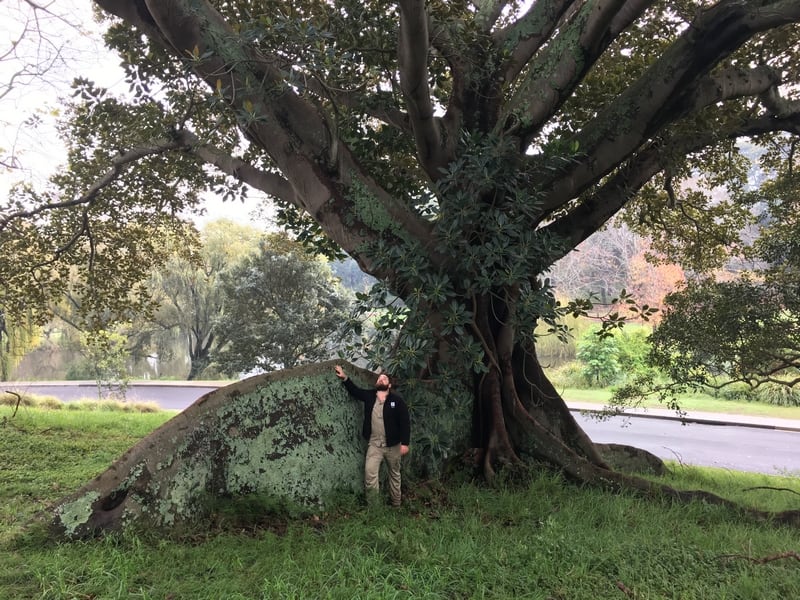 Location: Darley Road Slopes, Musgrave Avenue Precinct
Location: Darley Road Slopes, Musgrave Avenue Precinct
This tree is known locally as the Mighty Buttress Tree, and for good reason! This striking tree anchors itself to the ground with a huge buttress root that stands taller than me at over six feet above ground level.
Buttress roots, which this species is famous for, supports and reinforces the tree to stop it from falling over. Like muscles in people, trees develop reaction wood in response to immense loads that are imposed onto them through their life and buttressing is one of these biomechanical responses.
It is another great example of nature’s superior engineering as it resembles an RSJ or I-beam in structure. This is, by far, the Parklands tallest fig buttress.
The slow-growing lichen living on its scaffolds reminds me of a patina that has tarnished a copper surface through exposure to nature over a long time. I personally feel dwarfed and in awe of the tree when standing next to it.
Stop 6: Liquidambar orientalis, Turkish sweet gum
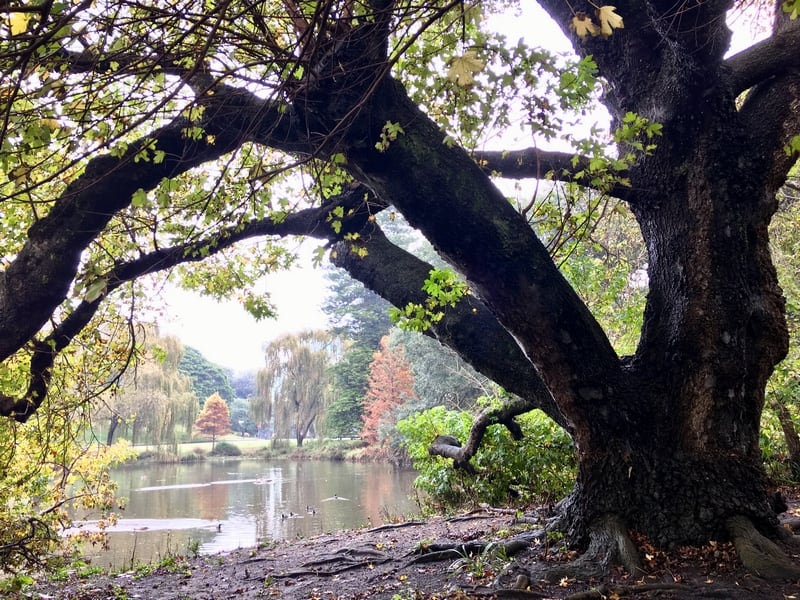 Location: One More Shot Pond, Musgrave precinct, Centennial Park
Location: One More Shot Pond, Musgrave precinct, Centennial Park
This Liquidambar (and its partner to the North) is different from most you see planted across Sydney, because of its distinctly different form, dense arrangement of leaves and its beautifully dissected, deeply lobed leaf margins. It grows out and down towards the ground where it spreads and creates dense walls of foliage.
Although it has lost some large limbs on its Southern side in recent years, the framed vistas out onto One More Shot Pond, combined with the peace and tranquillity within its branches remains undisturbed.
I love that it only opens its branches in a couple of hidden spots and as I enter its canopy, I feel as if I’ve discovered a secret place not many have experienced. Whether it be in autumn or winter when the canopy thins and lets the light in, or in spring into summer where it feels more like a protective cave, a connection with nature through this tree is hard to ignore.
Stop 7: Ficus rubiginosa, Port Jackson fig
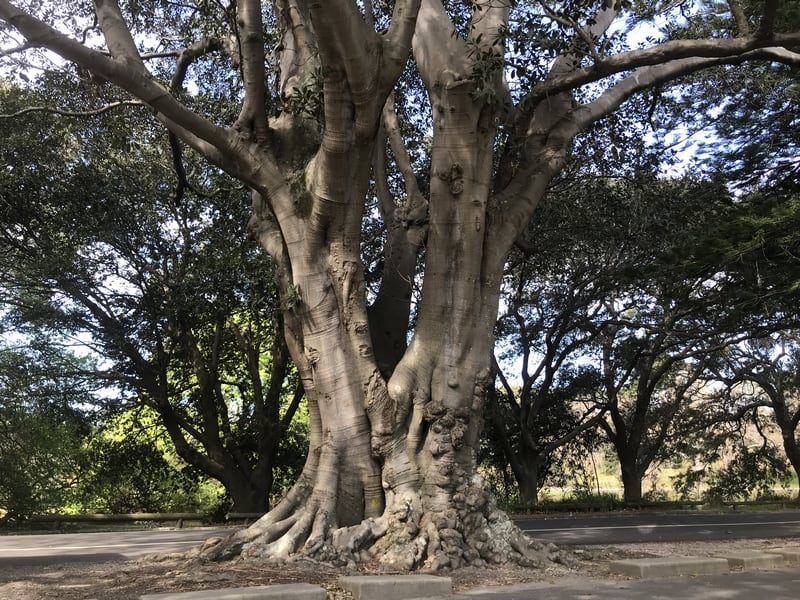 Location: Grand Drive east, Centennial Park
Location: Grand Drive east, Centennial Park
Another champion tree and one of the largest Port Jackson figs planted in 1897, now growing within the road surrounds along Grand Drive.
This trees’ roots must have exploited and tapped into one or more of the surrounding ponds long ago. Tree roots don’t grow deeper than they need to, which is seldom deeper than half a metre underfoot. I’d imagine that this giant’s roots would be concentrated far from its base along the borders of these ponds. Take a moment to walk around its base whilst looking up along its limbs to take in the sheer volume and height.
This tree also reminds me of the resilience of amenity trees, to be able to thrive and grow so large regardless of the stresses; sealed hard surfaces that meet its trunk, and the countless vehicles that have parked on its roots for more than half a century now. The protuberance’s around its base reflects its old age and the respect this one deserves. Be sure to touch this one as you walk past it!
Stop 8: Liquidambar styraciflua, Sweet gum (grove)
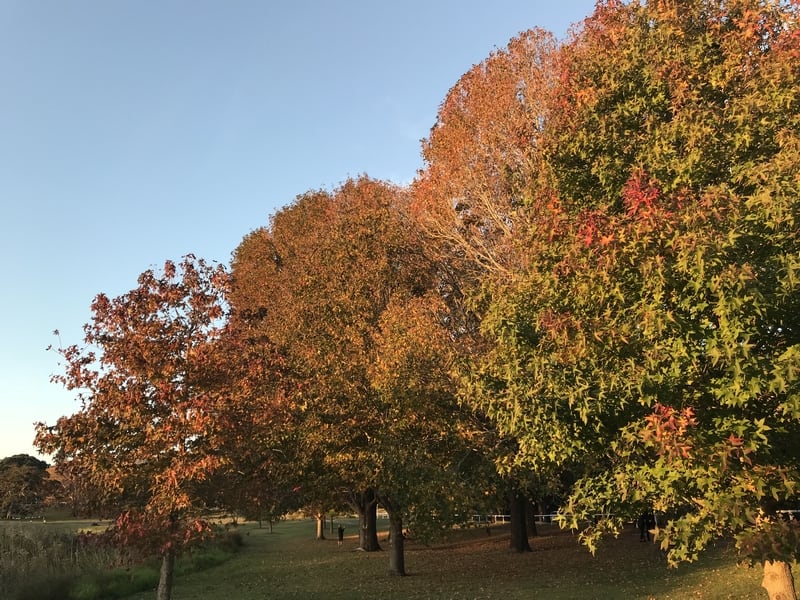 Location: Willow Pond south, Centennial Park
Location: Willow Pond south, Centennial Park
The autumn hues displayed from this group of Liquidambars is breathtaking for any passer-by through the months of May and June. This tightly grouped planting of mature trees forms a backdrop to a complimentary row of young trees of the same species and a mix of other deciduous trees on the banks of Willow Pond.
This display is arguably one of the best autumn colour displays in Sydney and is best viewed from the eastern side of Willow Pond. This species is one of a handful of reliable deciduous tree species in our temperate Sydney climate, which shows off the full spectrum of autumn colour, from golds, oranges, scarlets to deep purples.
They are beautiful large shade offering trees the rest of the year round and one of my personal favourites as a climbing arborist for a swing around and branch walk amongst its canopy. There is something magical about walking through the grove on a sunny but cool autumn day whilst you kick up the crispy fallen leaves.
The autumn colours are mirrored by Willow Pond and contrast with a fluorescent blue sky. The scene is exceptionally photogenic and well worth a Sunday drive to experience.
Stop 9: Salix sp., Weeping willow (grove)
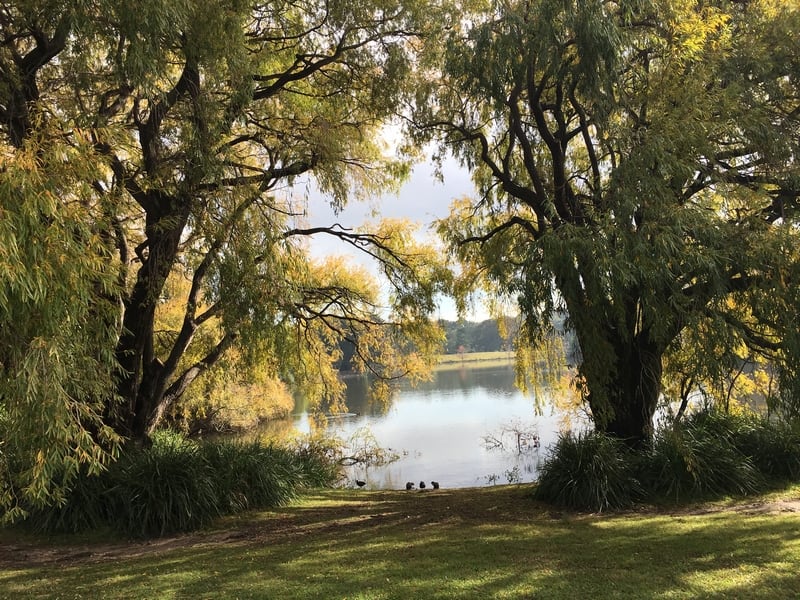 Location: Willow Pond south-west, Centennial Park
Location: Willow Pond south-west, Centennial Park
Weeping willows naturally propagate themselves along river banks or country streams and are perfect for lining the banks of a parkland pond.
They are characterised by their drooping branchlets that gently sweep the pond surface and are reminiscent of the Victorian-style tradition which is synonymous with Centennial Park’s design.
These three trees are some of the oldest willows in the Park, planted in the 1930’s and epitomise the romantic nature and feeling of a peaceful river bank for me.
When standing between them, it wouldn’t feel out of place to witness a game of croquet and a Victorian-style picnic. They frame one of the most serine vistas in the Park and at whatever time of year, you are bound to share the moment with a few ducks under their hirsute canopies.
During autumn these two trees turn butter yellow as they begin to transform into their bare, leafless state through winter.
Stop 10: Melaleuca quinquenervia, Broad leaved paperbark (grove)
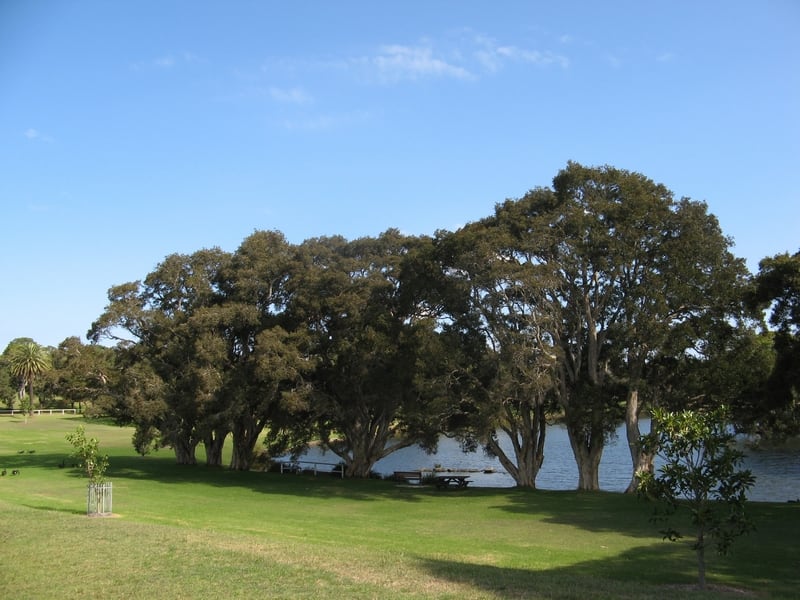 Location: Duck Pond east, Centennial Park
Location: Duck Pond east, Centennial Park
Melaleucas are the most abundant tree in Centennial Parklands and were introduced to this park setting by Joseph Maiden, Director of the Royal Botanic Garden Sydney from 1896 to 1924. He considered paperbarks to be “shapely, shading objects of sylvan beauty”.
This native species selection was possibly his most visibly powerful planting contribution. A lesser known feature of Maiden’s planting style was his signature planting pattern, which can be seen (if you know what you’re looking for) around the Park in a few remaining locations.
This spot is one of the original plantings of Maiden and is recognised by the planting pattern, 3-1-3-1 etc. A tribute to Maiden’s contribution to Centennial Parklands was made by my predecessor, Ted Hoare, Senior Arborist of Centennial Parklands for over 30 years.
Ted organised the planting of ‘Maiden’s Row’ in 1999, which spans for hundreds of metres in between Kensington Pond and Alison Road of this species, replicating this planting pattern. Ted showed me this bit of history and inspired many about the history of the Parklands whilst he worked here and during his famous tree walks.
This particular group of trees dates back to 1896 and reminds me of the rich history of this place, as well as the invaluable contributions to the Parklands by key personalities like Ted. I love these paperbarks, which are synonymous with the ‘People’s Park’. Their presence today is a testament to Maiden as they continue to grow and thrive harmoniously with the various ponds and wetlands within our beautiful Park.
Hope you enjoy it!
If you've always wondered about the history and wildlife of Centennial Park, our self-guided walks help to bring the fascinating story of the 'People's Park' to life. We have self-guided walks, which you can find out more here.